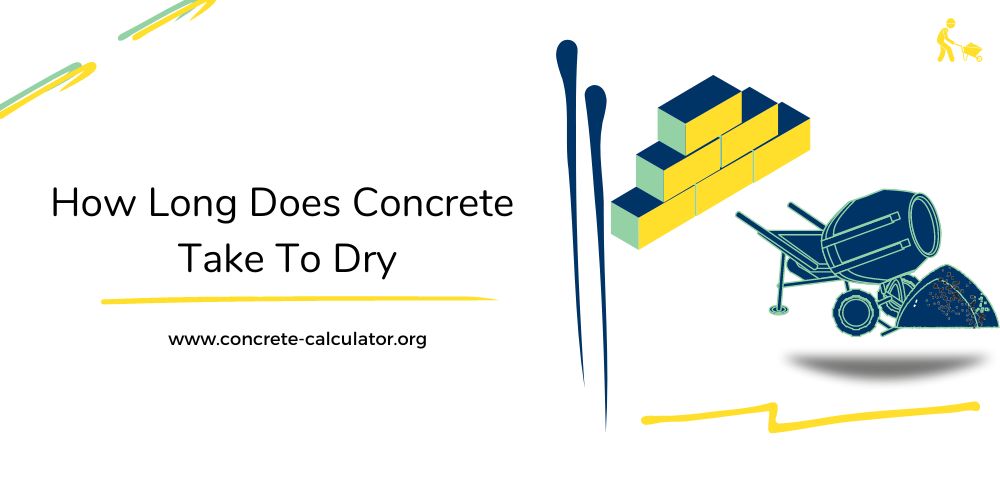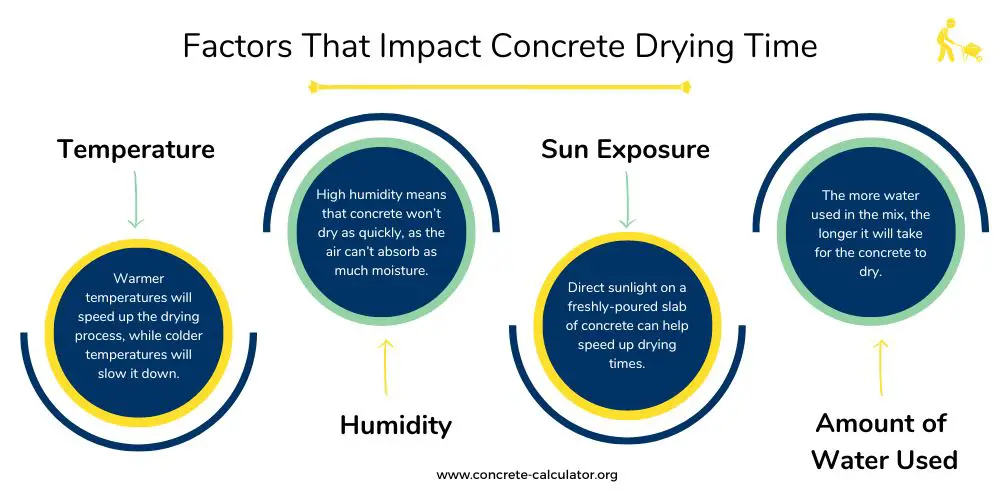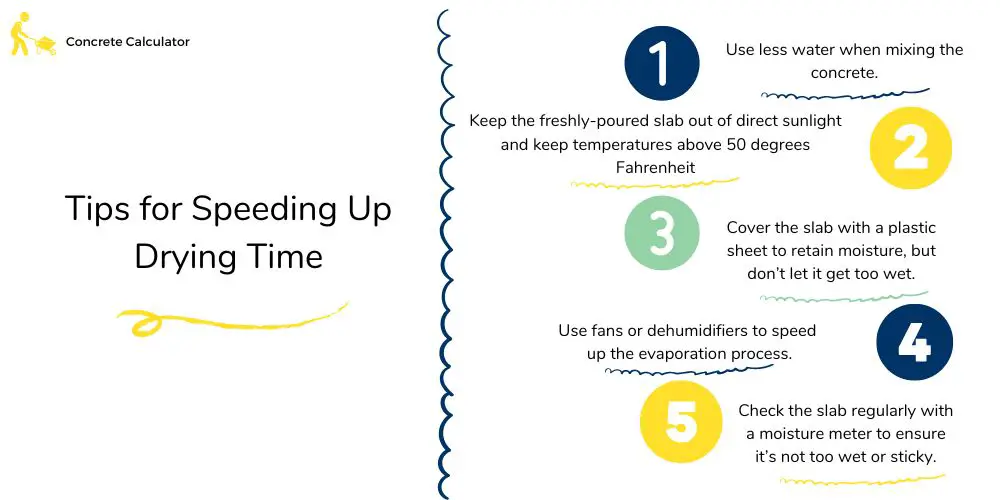Have you ever wondered how long it takes for concrete to dry? Understanding this process is essential for anyone who’s planning any kind of construction project that involves utilizing concrete. In some cases, you may even need to hire a specialist to ensure the safety and accuracy of your project.
Concrete typically takes 24 to 48 hours to dry, and gains its full strength in 28 days, although this depends on a variety of factors such as temperature, humidity, and the amount of water used in the mix.

So if you have questions about the drying time of concrete or want to know more, read on! We’ll review all the key factors that impact drying times and provide tips on what steps you can take during each stage to ensure your project is successful.
Difference Between Concrete Curing and Drying
Concrete curing and drying are different processes. Curing is the process of allowing concrete to harden and reach its full strength, while drying refers to the evaporation of excess water from a freshly-poured slab so that it won’t be soft or sticky when it’s fully cured.
Curing typically takes 28 days, and this process shouldn’t be rushed. The concrete should remain moist throughout the curing process to ensure that it reaches its maximum strength and durability.
Drying, on the other hand, typically takes 24 to 48 hours depending on a variety of factors. Once a slab is dry, you can move on to putting a sealer or paint on it and use it in whatever way you intended.
By utilizing a Concrete Calculator, you can accurately determine the necessary amount of materials, resulting in efficient drying and completion of the project.
Factors That Impact Concrete Drying Time
Although concrete typically takes 24 to 48 hours to dry, several factors can change this timeline. Here are some of the most important ones:
- Temperature: Warmer temperatures will speed up the drying process, while colder temperatures will slow it down.
- Humidity: High humidity means that concrete won’t dry as quickly, as the air can’t absorb as much moisture.
- Sun Exposure: Direct sunlight on a freshly-poured slab of concrete can help speed up drying times.
- Amount of Water Used: The more water used in the mix, the longer it will take for the concrete to dry.

The Concrete Drying Dilemma: My Experience
As I began my backyard patio project, I was eager to get started on pouring the concrete slab that would serve as the foundation for my new outdoor space. I meticulously measured and leveled the area, and before I knew it, the concrete truck was on its way. As the concrete was poured, I couldn’t help but feel a sense of excitement and accomplishment. But little did I know, my excitement would soon turn into a bit of a headache.
As the concrete began to dry, I noticed that the surface was not as smooth as I had hoped. I realized that the humidity levels were high that day and I didn’t use a curing compound, which slowed down the drying process. I had to wait an extra day for the surface to dry enough for me to smooth it out, and the overall curing process took around 7 days.
I learned my lesson and made sure to consult with a professional and follow proper curing techniques for the next pour. I also named my project as ‘Backyard Patio Project’. Overall, the concrete drying process can be a bit tricky, but with proper planning and execution, you can achieve a strong and durable final product.
Also Check: How To Remove Oil Stains From Concrete?
Tips for Speeding Up Concrete Drying Time
If you’re looking to speed up the drying time of your concrete, here are a few tips that can help:
- Use less water when mixing the concrete.
- Keep the freshly-poured slab out of direct sunlight and keep temperatures above 50 degrees Fahrenheit.
- Cover the slab with a plastic sheet to retain moisture, but don’t let it get too wet.
- Use fans or dehumidifiers to speed up the evaporation process.
- Check the slab regularly with a moisture meter to ensure it’s not too wet or sticky.

Testing The Concrete For Dryness
You should test your concrete for dryness before you walk on it or use it for any purpose. A quick and easy way to do this is to pour a few drops of water onto the surface. If the water beads up, then the concrete is still damp and needs more time to dry.
To be sure that your concrete is as dry as possible, you can also use a moisture meter. This tool measures the amount of water in the slab and will help you determine when it’s ready to be used.
Moreover, you can also perform a pull-off test to check the strength of the concrete. You’ll need to wait until the concrete is at least 28 days old before performing this test, as it will give you a good indication of how strong and durable your project is.
4-Inch Concrete Curing Time
If you’re pouring a 4-inch slab of concrete, the drying time will typically be 24 to 48 hours, depending on the factors mentioned earlier but the curing time will take much longer. Curing is an important process for gaining full strength, so you should always allow at least 28 days for this step.
Again, it’s important that you monitor the slab with a moisture meter or perform a pull-off test before using it.
Also Read: How Many 80 lb Bags of Concrete On a Pallet?
FAQs
Is it OK if it rains after pouring concrete?
Yes, it’s usually fine if your concrete has been poured and has had a chance to start drying. However, you should cover the slab in
Why is it important to know how long concrete takes to dry?
It’s important to know how long concrete takes to dry so that you can plan your project accordingly and ensure that the slab is strong and durable.
What are the dangers of rushing the drying process of concrete?
Rushing the drying process can lead to weakened concrete, which can result in cracking and instability. It’s best to follow the curing and drying times
What if it rains 3 hours after pouring concrete?
If it rains 3 hours after pouring concrete, you should cover the slab to protect it from further moisture. You should also monitor the slab with a moisture meter to ensure that it isn’t too wet or sticky.
Concluding Concrete Set Times
Now that you understand the process of concrete drying, you can be better prepared for your next project and know how long it will take in advance. Be sure to use these tips to speed up the drying process, and make use of a moisture meter or pull-off test to ensure that your concrete is as strong and durable as possible. With the right knowledge and preparation, you can ensure your concrete project is successful.
Happy Building!
I am John Doe, a licensed civil engineer and concrete expert. I received my degree in Civil Engineering from Washington State University and have been working in the field for 15 years. Based in Seattle, WA, I specialize in concrete projects and calculations. I have a passion for sharing my knowledge and experience through my website concrete-calculator.org
